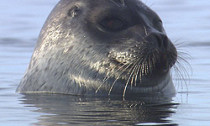
Scientists say they have solved the mystery of one of the most extreme adaptations in the animal kingdom: how marine mammals store enough oxygen to hold their breath for up to an hour.
The team studied myoglobin, an oxygen-storing protein in mammals’ muscles and found that, in whales and seals, it has special “non-stick” properties.
This allowed the animals to pack huge amounts of oxygen into their muscles without “clogging them up”.
The findings are published in Science.
Dr Michael Berenbrink from the Institute of Integrative Biology at the University of Liverpool took part in the study.
He said that scientists had long wondered how marine mammals managed to pack so much of this vital protein into their bodies.
“At high enough concentrations, [proteins] tend to stick together, so we tried to understand how seals and whales evolved higher and higher concentrations of this protein in their muscles without a loss of function,” he told BBC News.
The team extracted pure myoglobin from the muscles of mammals – from the land-based cow, to the semi-aquatic otter, all the way up elite divers like the sperm whale.
Led by researcher Scott Mirceta, this painstaking examination traced the changes in myoglobin in deep-diving mammals through 200 million years of evolutionary history.
And it revealed that the best breath-holding divers in the mammal family had evolved a non-stick variety of myoglobin.
The secret, Dr Berenbrink explained, was a subtle but crucial piece of chemical trickery; marine mammal myoglobin is positively charged.
This has important physical consequences. Dr Berenbrink explained: “Like the similar poles of a magnet; the proteins repel one another.”
“In this way we think the animals are able to pack really high concentrations of these proteins into their muscles and avoid them sticking together and clogging up the muscles.”
Dr Berenbrink said he was excited by the discovery because it helped make sense of the incredible changes that took place in mammals’ bodies as they evolved from land-based animals to the aquatic, air-breathing creatures that inhabit the oceans today.
It showed, he said, the physiological change that accompanied the land to water transition of mammals.
“It also allows us to estimate the dive times of the ancient ancestors of whales,” Dr Berenbrink explained.
“We can look the fossils and predict the dive times they had.”
Understanding exactly how mammals’ bodies store oxygen so efficiently could also aid medical research.
Copying this bit of natural chemistry could aid the development of oxygen-carrying liquids that would deliver emergency supplies of oxygen to a person’s tissues when a blood transfusion is not possible.
But its biggest impact will be in the realm of evolutionary biology.
Nicholas Pyenson, curator of fossil marine mammals at the Smithsonian Institution in Washington DC, said that the study was an exciting advancement for understanding the evolution of deep-diving.
“The idea that we can estimate maximal dive times for early diverging relatives of today’s marine mammals will have a profound impact on how we think about their ancient ecology and biology,” he told BBC News.
Professor Michael Fedak from the University of St Andrews’ Sea Mammal Research Unit pointed out that myoglobin was only “part of the story” of how marine mammals were able to dive.
“But it’s an important part,” he said.
The scientist, who was not involved in this study, explained that a great deal of research at the moment was looking into how marine mammals manage to survive repeatedly cutting off and re-establishing the blood supply to their body tissues, something he likened to repeatedly suffering a crush injury.
“But being able to pick up a few [fossilised] bones of an extinct marine mammal and estimate its dive time from that – that’s miraculous.”











Social Profiles